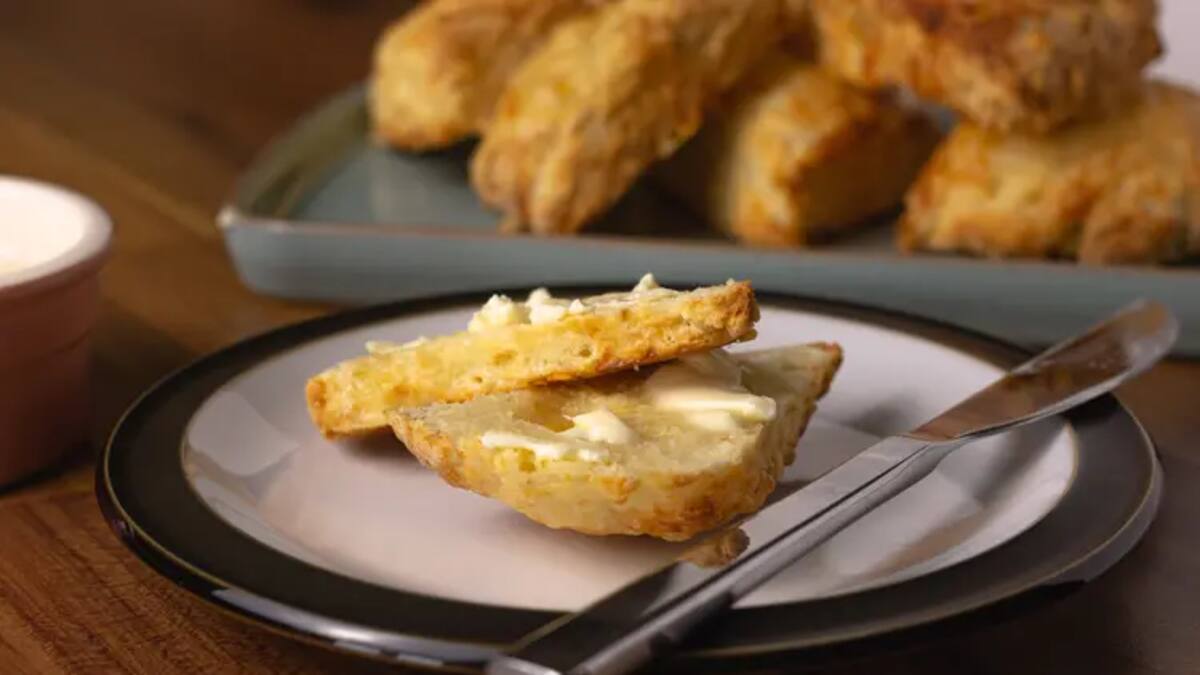My ability to transmute pantry staples into edible goods has not improved in the decades since. Any scone not consumed within five seconds of leaving my hot oven cools to a stone that I must eventually biff on the lawn (taking care not to hit sparrows or butterflies).
The birds ignore my scone rocks. They grow mould. It rains. Eventually, poetically, the entire floury fiasco dissolves into scone glue. It is an effective weed suppressant, but it is not, in any way, shape or form, morning tea.
The great pity of this is that I really like scones. The best bridge between breakfast and lunch is the claggy crumb of a butter-soaked scone. Nothing says “I’m so happy you stopped by” like a cup of tea and the waft of warm cheese and oven-fresh flour. And, in your 50s, absolutely nothing proves you mastered being an 11-year-old girl from provincial New Zealand like the ability to whip up a scone that will not break windows.
My mother-in-law and father-in-law make a great cheese scone (and so does their son). I live in Auckland, a city that accounts for almost 40% of the country’s hospitality spend, and some of that is definitely on very good scones.
Hill House Cafe’s $27 Pimp My Cheese Scone OG made the 2025 Auckland Iconic Eats top 100 list. Photo / Babiche Martens
I’ve never managed to get up early enough to beat the queues to sample the much-lauded scone at Avondale’s Burnt Butter, but I did, recently, sample the “Pimp My Cheese Scone OG” at Hillsborough’s Hill House Cafe. (While it thoroughly deserves its place on the 2025 Auckland Iconic Eats list, and I didn’t need to eat again until Sunday, I wish I could see the look on the South Island’s face as it reads that I spent almost $27 on a brunch-adjacent scone.)
Where is the best scone in the country, and why is it at a public library in Christchurch?
In August, in Ōtautahi for its excellent WORD festival, I indulged a whim that became an obsession.
The Christchurch library scone came with a 17g side of butter – the equivalent of more than three teaspoons.
For four days straight, at the Foundation Cafe on the ground floor of Tūranga (central Christchurch’s new library complex), I breakfasted on a cheesy behemoth.
Eleven centimetres across and served with a 17g side of butter that made me wonder if I’d just imagined the cost-of-living crisis, it was the platonic ideal of a scone. Canterbury may have been compromised by dairy cows, but the fruits (milk?) of their labour have not hurt its baking.
In news that did not surprise me, Foundation owner Sarah Niu said these wondrous scones, baked fresh daily from a mix prepared by the cafe’s pastry chef, contained “a lot more butter and cheese compared to the normal scone”. And, while a recent price increase (from $6.50 to $8) had upset some regulars, the cafe was still selling between 80 and 150 daily.
“I believe it’s a traditional thing to sit down with a cup of tea or coffee and a scone and relax with a book,” said Niu.
At the time of writing, I am reading the new Thursday Murder Club novel. It’s more lemon and raspberry sponge than cheese scone, but I think Niu has a point. Baking does have an affinity with books. If a night in front of Netflix is a block of store-bought Whittaker’s, then the printed word demands a more analogue approach. It takes more than a minute to write a book, and the least I can do is curate my snacks accordingly.
(Side note: Not all library scones are created equal. Auckland Central City’s $5 offering was cheaper, but it came with just 9g of butter, and its crumb lacked both the cheesy cohesion and tender spring of its southern counterpart. It was the film version of a book that deserved better.)
New Zealand’s love of the scone is not unique, but apparently our predilection for cheese is.
“We do them differently here,” note Te Radar and Ruth Spencer in their gorgeously readable new book Kiwi Country: Rural New Zealand in 100 objects.
“In the UK, they’re slightly sweetened and often contain lurking sultanas. In the US, the most similar thing is called a biscuit, which is just annoying. Overseas, you’ll struggle to find such a delicacy as a cheese scone at all, and it’s one of the things most regretted by New Zealanders living abroad …”
The scone’s popularity, the authors moot, might lie in the ease of its production: “It actually rewards less work. The overly handled scone is a tough bird.”
I turned the page, emboldened and enlightened. The trick to a great scone? Less kneading, more reading.
Kim Knight is a senior journalist on the New Zealand Herald’s lifestyle desk. She has a master’s in gastronomy, but this has not helped her make a decent scone.

